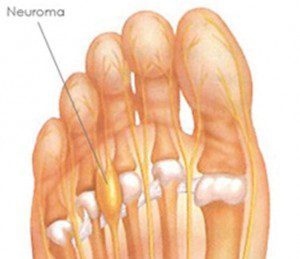By Brian K. Doerr, DPM, Fellow of the American College of Foot & Ankle Surgeons –
 Some who suffer from this painful foot condition might say “it is a real pain in the foot”. This condition is often referred to as a pinched nerve. Simply put a foot neuroma is a swollen (inflamed) nerve in the ball of the foot, commonly between the base of the second and third toes. A foot neuroma is a benign growth of nerve tissue. “Pins and needles” is often a phrase used when patients try to put into words the pain they are feeling.
Some who suffer from this painful foot condition might say “it is a real pain in the foot”. This condition is often referred to as a pinched nerve. Simply put a foot neuroma is a swollen (inflamed) nerve in the ball of the foot, commonly between the base of the second and third toes. A foot neuroma is a benign growth of nerve tissue. “Pins and needles” is often a phrase used when patients try to put into words the pain they are feeling.
It brings on pain, a burning sensation, tingling, or numbness between the toes and in the ball of the foot. Some people who suffer from this foot condition just need simple treatments including modification of their footwear. Sometimes surgery is needed for long-standing (chronic) symptoms.
It is more common in women who habitually wear high-heeled shoes or in men who are required to wear tight (constrictive) footwear. It may also be more common in ballet dancers. The symptoms can vary and may come and go over a number of years. For example, some people may experience one or two attacks of pain in a week and then nothing for a year. Others may have regular and persistent (chronic) pain.
Podiatric medical care should be sought at the first sign of pain or discomfort. If left untreated, neuroma tends to get worse.
Symptoms
The most obvious symptom associated with a neuroma is pain between the toes while walking. Those suffering from this condition often find relief by stopping their walk, taking off their shoe, and rubbing the affected area. At times, people who suffer from neuroma will describe the pain as similar to having a stone in his or her shoe. A feeling that you are stepping on something or that something is in your shoe are often usual complaints.
. Pain in the forefoot and between the toes
. Tingling and numbness in the ball of the foot.
. Swelling between the toes as well as pain in the ball of the foot when weight is placed on it are all symptoms of a neuroma.
A number of factors can contribute to the formation of a neuroma. High arc or flat food can lead to a formation of a neuroma. Trauma can also cause nerve damage causing inflammation. Improper footwear that causes the toes to be squeezed together can cause a neuroma. repeated stress that is related to your job can cause or aggravate a neuroma. Some high-impact sporting activities – including running, karate, and court sports. Any sport that places undue pressure on the feet.
There are surgical as well as non surgical treatments for people who suffer with a foot neuroma.
Non Surgical treatment options:
Footwear adjustments: including avoidance of high-heeled and narrow shoes and having special orthotic pads and devices fitted into your shoes.
Calf-stretching exercises: may also be taught to help relieve the pressure on your foot.
Steroid injections: into the affected area of the foot may be needed if the simple footwear changes do not fully relieve symptoms. However, the footwear modification measures should still be continued.
Alcohol sclerosis injections: Is a special alcohol solution that can be injected over the nerve that is damaged. This solution will target only the nerve tissue. It will slowly over several injections, deaden the nerve. The loss of the nerve can then leave the patient symptom free. Treatment is customized to the patients individual needs.
Surgical treatment options: If the non-surgical measures do not work, surgery is sometimes needed. Surgery normally involves a small incision being made on either the top, or the sole, of the foot between the affected toes. Usually, the surgeon will then either create more space around the affected nerve or will cut out the affected nerve. You will usually have to wear a special shoe for a short time after surgery until the wound has healed and normal footwear can be used again.
If you suspect neuroma, it is essential that you confirm your suspicions by consulting with a podiatric physician. Dr. Brian Doerr believes when you have problems with your feet, you need to turn to a podiatrist who listens and responds he is an experienced Doctor who knows the field and can effectively diagnose and treat your needs.
Don’t wait for the symptoms to go away for good (even if they tend to come and go). Also, remember that many conditions have similar symptoms, and only a professional can tell the difference. Assist them by describing your condition as well as you can.
Keep track of when the symptoms started and how, any changes you’ve noted (whether the pain has gotten worse, or whether other symptoms have appeared as well, etc.). If you’ve noticed that certain activities or footwear make things worse or bring about additional symptoms, be sure to mention that. If you work in specific footwear discuss that as well. Put your feet first. Dancing is the poetry of the foot so call today to set up your consultation with Dr. Doerr if you are experiencing any symptoms of neuroma so your path to healing can begin.







